1969 German Grand Prix race report: Ickx props up Brabham
Jacky Ickx takes a dominant first victory for Brabham, being the sole representative for team after boss is injured in testing; BMW F2 driver Gerhard Mitter killed in practice accident
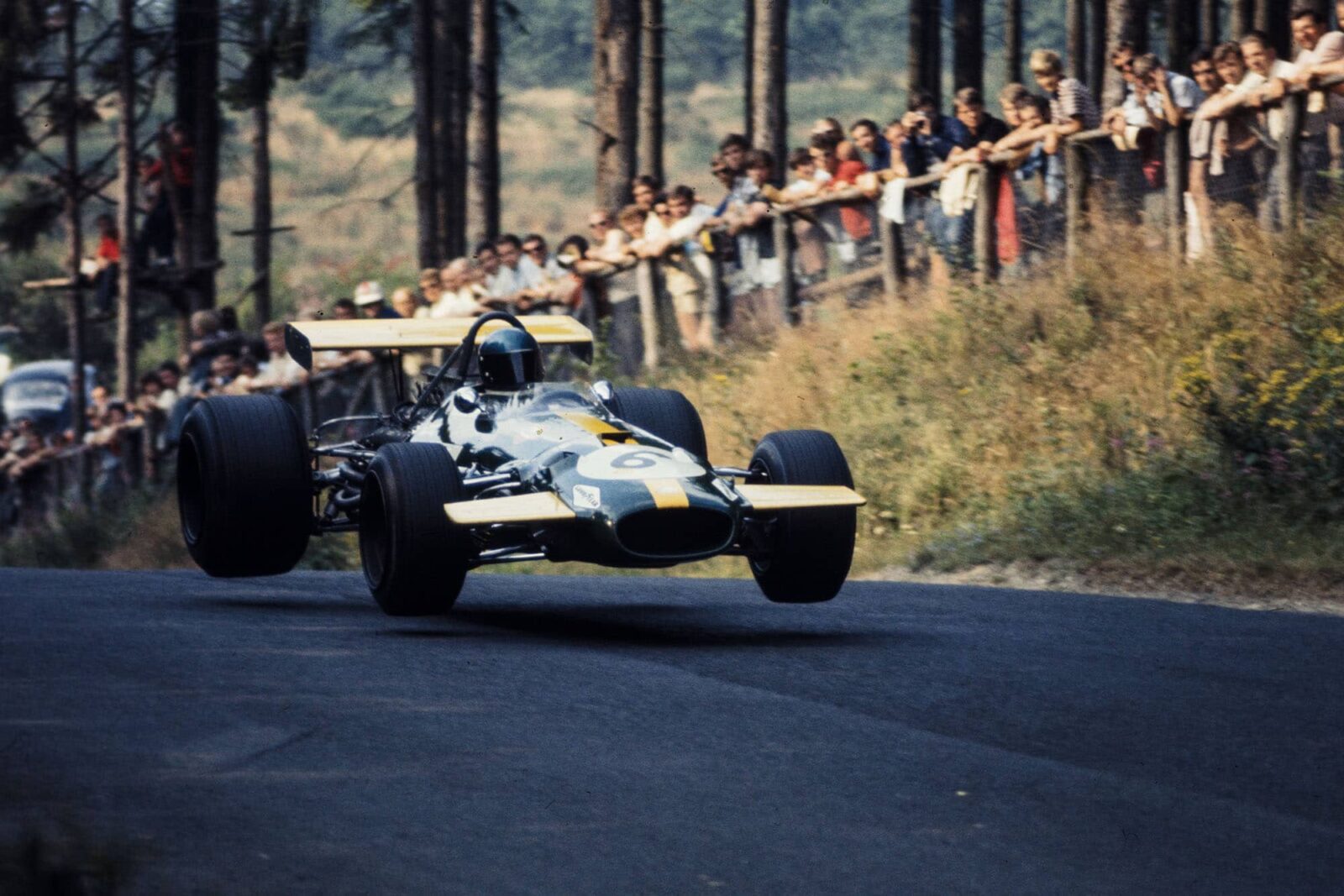
Jacky Ickx won his first race if the season for Brabham
Motorsport Images
After the 1,000-kilometre race in June, when Siffert set the fastest lap of the Nürburgring in practice at 8min 00.2sec with a Porsche 908, and Amon did 8min 00.3sec with the Ferrari 312P, I remarked that no self-respecting Grand Prix driver would be content with a lap sit over 8 minutes if practice for the Grand Prix would be held in dry weather.
The weather on Friday and Saturday before the Grand Prix was superb and the Nürburgring and the Eifel were at their best. When the Nürburgring is at its best it is terrific, when it is at its worst, like last year, it is awful. I fully expected the top Grand Prix driver to rise to the challenge of achieving a lap in under 8 minutes, but in my wildest dreams I did not anticipate anyone getting nearly 20 seconds under bogey time, nor did I expect so many drivers to excel themselves.
The German Grand Prix is much more than another race in the World Championship series in which to gain more points for the Championship, it is the Nürburgring, and that is a driving challenge that is hard to equal anywhere.
To drive a fast lap of the Nürburgring is as satisfying and challenging to Grand Prix driver as is a fast lap of the Isle of Man TT course to the real racing motorcyclist. Wheel-to-wheel racing and cut-and-thrust tactics are of little importance at the Nürburgring, with its myriad of corners of every description in its 22.8 kilometres (14 miles), its steep descents that bring out the bravery in a driver, its fast corners that bring out the skill and above all the whole fantastic character of the circuit that throws down the gauntlet of a real challenge to anyone who thinks he can drive a racing car.
The Gods of the Nürburgring who lurk among the forest-clad slopes seem to say “Here is the circuit as it was laid out in 1925, come and beat it if you can, but bring a strong car and be brave and skilful, for this is for true men.”
With a heat-wave covering the Eifel mountains everyone was in good humour and were soon giving of their best, the first practice session being on Friday morning. At the last moment Ferrari withdrew his entries for Amon and Rodriguez, reducing the field to fourteen, but what it lacked in quantity it made up in quality.
Team Lotus had finally managed to drag Andretti away from his American racing commitments and he was to drive the 4-wheel-drive Lotus 63 that Miles had run at Silverstone. Andretti is fully convinced of the future of 4-wheel-drive and does not want to waste time with the old Lotus two-wheel-drive models, and he has the full support and backing of everyone at Lotus.
Since Silverstone the gearbox and power dividing unit had undergone a lot of testing and improving as regards lubrication and the brake calipers had been improved. It had been found that they had a tendency to stick on after application, the rigid inboard mounting on the Lotus 63 eliminating any deflections normally experienced with outboard mountings, there deflections helping to return the brake pads after application to give running clearance.
The resident Team Lotus drivers Hill and Rindt were driving 49B models, the former number 10, a newly built-up car, and the latter number 6, that he had driven at Silverstone. The car number 8 that Hill had driven at Silverstone had now been delivered to Bonnier. The shortage of petrol debacle at the British Grand Prix was not as simple as it looked and the 49B cars had undergone a complete revision of the piping and tank pick-up pipes to prevent a recurrence, for there had been adequate petrol in the tanks, but the pumps had not picked up the last few gallons.
Ickx was on his own with the Brabham team cars, having BT26-3 and BT26-4 to choose from, and preferring the newer one. Brabham himself was present on crutches, and planning to return to the cockpit for the Italian Grand Prix. Stewart and Beltoise had the two Matra MS80 cars, the crashed Silverstone one having been repaired, and the 4-wheel-drive car was an extra entry with no driver nominated for it.
The 4-wheel-drive McLaren was entered but did not appear, McLaren and Hulme contenting themselves with the two cars they have been using all season, abandoning their tray-like engine covers for separate aerofoils mounted on short struts, like a lot of other people were using now that the regulations were more clear and the aerofoils did not have to be part of the bodywork, limitations being on height, width and anchor points.
Surtees was driving the latest BRM with strengthened front suspension members and attempts had been made to spread the power and torque of the 12-cylinder engine lower down the speed range. This latest BRM also had a new and enlarged air deflector over the central exhaust system. With Surtees now committed to the new car, Oliver took over P138-01, the interim car with BRM gearbox.
The remaining four entries were private owners, Siffert in the Walker/Durlacher Lotus 49B, Courage in the Williams Brabham, full of confidence after the Silverstone race, Elford in Crabbe’s McLaren with the pontoon tanks, and Bonnier with his newly ‘acquired Lotus 49B, which the Parnell team were looking after for him.
As this small entry could well become lost from view on the Nürburgring a Formula Two race was to be run concurrently, starting from a separate grid behind the German Grand Prix. With all the graded drivers in the Grand Prix the Formula Two entry took on a proper perspective and all the likely German drivers were involved.
The Winkelmann team took on Herrmann and Stommelen in the Lotus car that Hill and Rindt usually drive, Matra entered Pescarolo and Servoz-Gavin, a full BMW works team were in the hands of Hahne, Mitter and Quester, while Tecno entered Cevert and Frank Williams entered Attwood. The list was completed by Ahrens, Westbury and Perrot with their private Brabhams. Apart from the works BMW cars everyone was Cosworth FVA-powered.
Qualifying
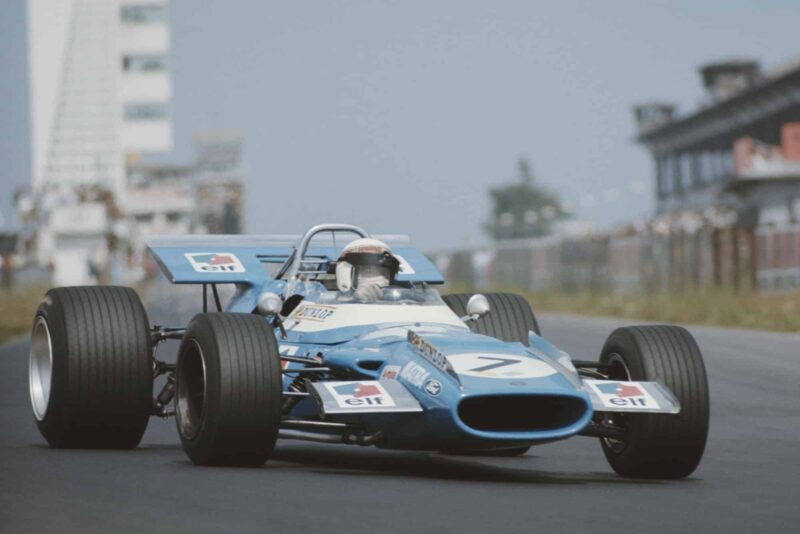
Stewart qualified 2nd behind Ickx
Motorsport Images
The Friday morning practice session passed smoothly and with only minor incidents, except that Andretti only got a few miles in the 4-wheel-drive Lotus when a camshaft broke and valves and pistons and connecting rods all became a tangled mess. Someone had told Siffert that practice was in the afternoon and he arrived just before the morning practice finished and could not get in a flying lap.
Since the erection of the guard rail down the pit lane it is no longer possible to be timed on a standing-start lap, competitors having to cover a full lap before the timekeepers acknowledge their existence. It is still possible to go round and round the short pit-circuit to make sure everything is working well before setting off for a full lap. If you do a full lap and enter the pit road instead of continuing on around the short pit circuit you do not record an official time.
Hulme was stuck out on the circuit like Andretti, when the Cosworth engine in his McLaren died with ignition failure. As expected it was Stewart who set the pace, with his MS80 Matra and he soon got under the bogey time of 8 minutes, followed by Rindt, but the Austrian was 2½ seconds slower than the Scot. The BRM pair were struggling to break 9 minutes, let alone 8 minutes and were not even competitive among the Formula Two competitors!
The Nürburgring offers unlimited opportunities for spectators to see Grand Prix driving at its best. It is an easy matter to position yourself at a point where cars come into view long before they are recognisable, and having come out of a fast bend or a series of bends the driver’s knowledge of the circuit and his ability can easily he seen by the speed at which he comes into view.
Ickx, Stewart and Siffert were outstanding on Friday afternoon, while Courage was impressive, Rindt was fast but did not look confident and McLaren was deceptively smooth and unruffled. Moving to a point where the cars went out of sight round a blind right hand bend, and being high above the track on a bank, it was possible to look down into the cockpits as they disappeared behind the trees.
“Rindt did not look as though he was enjoying himself and was reluctant to power-slide out of the corner”
Siffert and Ickx were going out of sight with the power full on and a lot of opposite lock, demonstrating that they not only knew exactly where they were going, but were complete masters of their cars. Stewart was only applying correction to power-steering when the need called for it, rather than deliberately provoking the situation like the other two. Rindt did not look as though he was enjoying himself and was reluctant to power-slide out of the corner.
Among the Formula Two cars Servoz-Gavin was outstanding and looked as though he could have used another 200bhp, while Pescarolo was not far behind him. While all this was going on tragedy was happening beyond the Flugplatz on the fast downhill sweep, for Mitter crashed in the works BMW Formula Two car and was killed. It was an accident that could only be attributed to a vital part breaking on the car, considering the point at which the car left the road and Mitter’s knowledge of the circuit.
A study of the Friday afternoon practice times more than confirmed the impressions gained by spectating. Ickx, Siffert, Stewart, Rindt and McLaren had all broken the 8 minute barrier, in that order, the young Belgian Brabham driver having recorded an unbelieveable 7min 44.2sec. It would have been unbelieveable had not three or four rival teams in the pits agreed with the official time.
Bearing in mind that Ickx and Siffert had already been to the Nürburgring once this season, with a lot of experience of fast laps, to say nothing of the hundreds of laps they have completed over the past four years, the pattern that was taking shape was to be expected. Both drivers love the circuit and treat it as a friend rather than a challenge, and were obviously as happy as the proverbial pigs in the proverbial fertilizer.
Stewart was viewing the circuit as a challenge to his ability and was proving that ability beyond question, but Rindt was succumbing to a lack of enthusiasm for the difficulties that the circuit provided, preferring the simplicity of a short circuit that he was capable of learning.
McLaren’s time of 7min 59.5sec was remarkable, for he did not look that fast, but was obviously applying thought and hard work to the job, rather than inspiration. As was expected Servoz-Gavin was way ahead of all the other Formula Two runners and virtually as quick as Surtees with the latest BRM. Oliver’s practice was short-lived as the fuel system on the second BRM went wrong, Bonnier was still awaiting the arrival of his “used” Lotus 49B, and Andretti was awaiting a new engine from England, Cosworth Engineering deliveries being behind schedule.
After the tragic accident to Mitter the remaining two works BMW cars were withdrawn, and Herrmann also withdrew as a mark of respect to his life-long friend. While certain sections of the racing world were sad and depressed, the rest continued with the battle, and the Eifel mountains continued to be bathed in sunshine, with conditions still perfect for high-speed driving.
“After the tragic accident to Mitter the remaining two works BMW cars were withdrawn, and Herrmann also withdrew as a mark of respect to his life-long friend”
The third and final practice session was on Saturday and further spectating from the excellent public enclosures merely confirmed which drivers had ability, which were enjoying themselves and which were wasting time.
Ickx improved his best time to 7min 42.1sec proving that his performance the day before was not a fluke, while Stewart responded to the challenge of the little Belgian with 7min 42.4sec, a remarkable equality bearing in mind all the variables in a lap of 22.8 kilometres.
Rindt tried as best he could, but there was no conviction in his driving and he openly admitted that the challenge of the Nürburgring had him beaten. Siffert was a real joy to watch but his lap time was down, explained by a lack of speed along the final straight, and when practice was finished he had his engine changed.
His own practice had stopped abruptly when the left front suspension broke, luckily with no other damage, Hulme and McLaren were both well under the 8 minute mark without any signs of excitement, their driving being neat and confident all along the line, and though Hulme was fifth fastest overall he was over ten seconds slower than Ickx and Stewart; the equivalent of one whole second on a 1½ mile circuit.
Courage did a rousing 7min 56.1sec, but he was surpassed by Elford with the Antique Automobiles McLaren, whose Porsche Nürburgring racing was obviously paying off. Hill did the last of the under-8-minute laps, there being a staggering total of nine self-respecting Grand Prix drivers. The Nürburgring certainly brings out the best in a driver.
Lotus got a new engine into their 4-wheel-drive car and Andretti set off to complete his first serious lap of the circuit. From a standing start he recorded 8min 58sec, his next lap was 8min 28sec, the next 8min 15sec and then another camshaft broke and the second Cosworth engine was wrecked. To achieve 8min 15sec on your second flying lap, having never been to the circuit before, and in a brand new car that had never been tried out against the vicissitudes of such a circuit, must surely stamp Andretti as a “natural” and justify the confidence that Lotus have in him.
A third engine was acquired and the mechanics started work willingly, such is the enthusiasm that a driver like Andretti instills into a team. Surtees did not record a flying lap with the new BRM as it suffered oil leaks and broken suspension, while Oliver could do no better than get among the Formula Two cars. Bonnier finally got his Lotus 49B but was so cramped in the cockpit that he could not bend his right arm to operate the gearlever, so had to change gear by reaching across the cockpit with his left arm; not conducive to fast driving.
Race
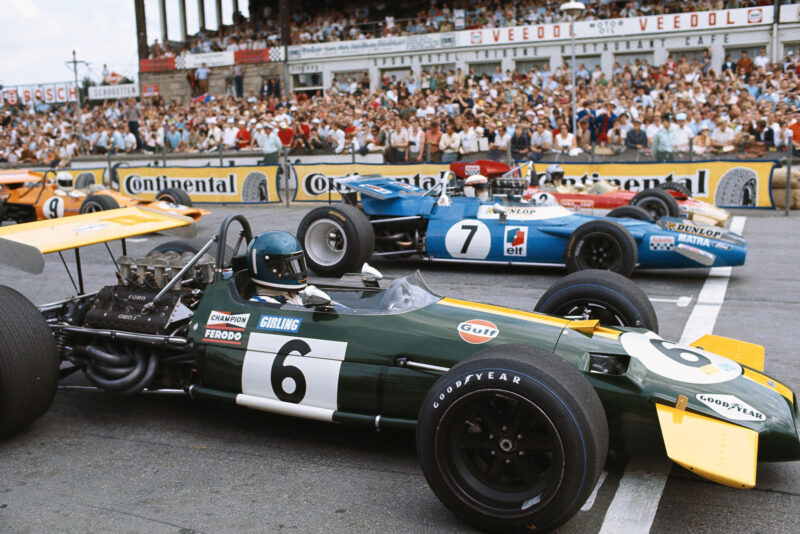
Ickx lines up next to Stewart on the grid
Motorsport Images
In spite of a short shower of rain after practice the superb weather continued throughout Sunday and a crowd of 350,000 was thought to be lining the circuit, and certainly the car parks and camping areas were full to overflowing. Surtees gave up the unequal struggle of battling against a team that has no unchallenged leader, like Chapman, Brabham or Tyrrell, and withdrew from the contest before the start, his empty place on the back of the grid hardly noticing. With conditions being perfect it was obviously going to be a record-breaking race between Ickx and Stewart, with the rest trying to keep pace.
“There were some hectic moments among the tail-enders and the official information service seemed to think Andretti had crashed”
For once Ickx made a good start from pole position, but a lot of other drivers made better starts, particularly Stewart, Siffert, Rindt and Hulme and the young Belgian lad was engulfed as the field poured into the South Turn. Stewart was away and not waiting for anyone, though Siffert and Rindt were chasing hard, while Ickx was down in eighth place. Around the North Curve there were some hectic moments among the tail-enders and the official information service seemed to think Andretti had crashed, but it was not true.
However, two-thirds of the way round the first lap the American did crash and Elford, who was just behind, became involved. The 4-wheel-drive Lotus and the McLaren were wrecked and Elford was taken to hospital with a badly broken arm, while Andretti escaped unscratched.
At the end of the opening lap Stewart had a six second lead over Siffert and Rindt, but Ickx was right behind them and going like the wind. He had come up behind McLaren, Hill and Hulme, who were together, so fast that they had moved smartly out of his way. Halfway round the second lap Courage took a downhill bend too sharply, the Brabham grounded with full petrol tanks and next thing the young Etonian found himself in the ditch with a very bent motor car.
With a clear road ahead Stewart was making the most of it and had a nine second lead over Siffert, but Ickx was past Rindt and was alongside the dark blue Lotus 49B. Stewart’s standing lap had been in 8min 02.5sec, and his first flying lap took 7min 50.9sec, and there was obviously more to come, but it came from Ickx, who went round on his third lap in 7min 45.9sec—176.4kph (about 109mph average). All the way round he was closing the gap, having disposed of Siffert very quickly.
This was a superb sight, the Matra giving all it had got, but the Brabham was closing on it relentlessly, the driving of Ickx being inspired. Behind these two there was no race, Siffert, Rindt, Hulme, Hill, McLaren and Beltoise looking very second-rate, while Oliver had the Formula Two cars of Servoz-Gavin, Pescarolo and Cevert snapping at his rear wheels.
As Stewart streaked along the undulating final straight Ickx pulled right up into his slip-stream and then pulled out alongside the Matra as they approached the flat-out left-hander under the Antoniusbuche. Being badly placed on the inside Ickx had to give way, and he followed the Matra into the chicane at Tiergarten and was alongside as they passed the pits. Once again he was on the wrong side and a valiant attempt to pass going into the South Turn did not come off.
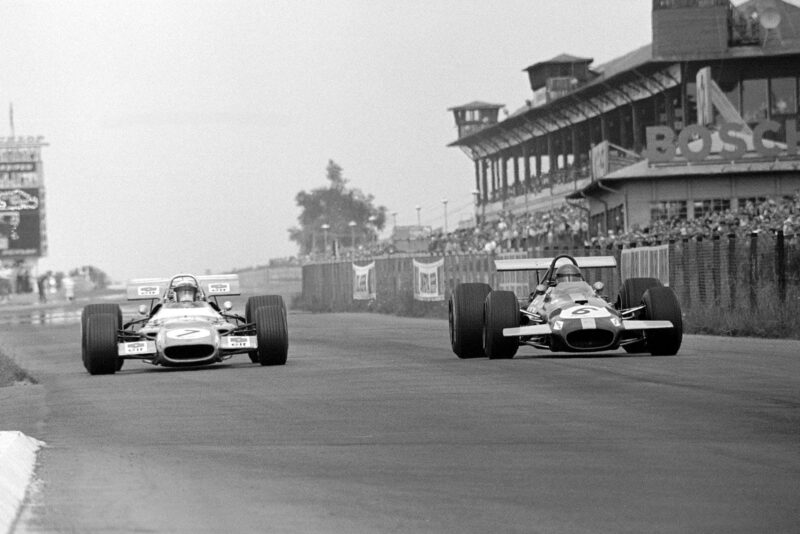
Stewart and Ickx dice down the main straight
Motorsport Images
The fourth lap had taken Ickx 7min 44.5sec and excitement was overflowing all round the circuit. Try as he did the Belgian could not out-smart the Scot, and Stewart was not going to give his young rival an opening. Almost unnoticed Bonnier crept into the pits and retired with a leaking petrol tank in his “new” Lotus after four laps.
All round the fifth lap the battle continued with Ickx trying desperately to get by the Matra, but all to no avail and they finished the lap still nose-to-tail. Everyone else had been left way behind, the rest following in the order Siffert, Rindt, Hulme, Hill, McLaren and Beltoise, with Oliver tailing along in the background.
As the two leaders came up the back straight behind the pits into the North Curve Ickx made a desperate do-or-die attempt and went by on the inside under braking. In a cloud of dust and locked wheels he went across the apex of the corner, slid out wide and Stewart dived through behind him and retook the lead; it was truly heroic motor racing.
Undaunted, Ickx continued to harry the Scot all round the sixth lap, the two of them averaging nearly 108mph in a breath-taking battle of sheer driving skill. As they crested the rise of Tiergarten Ickx was a few feet closer and alongside as they passed the pits. He sat it out with Stewart, wheel-to-wheel as they raced towards the South Turn and this time he was into the corner first and leading as they came back up behind the pits.
With a clear road ahead Ickx used everything the Brabham could give and set yet another lap record with a time of 7min 43.8sec, which gave him a narrow two second lead on Stewart. By now Siffert and the others were so far behind they seemed to be in a different race, and when Rindt’s engine went a bit flat and he dropped from fourth place to eighth place, behind Beltoise, it did not seem very important.
During this falling back McLaren got ahead of Hill so the order of the “also rans” was Siffert, Hulme, McLaren, Hill, Beltoise, Rindt, Oliver. When you realise these “also rans” were averaging well over 100mph round the Nürburgring you can appreciate the pace of the leaders.
“For two laps Stewart kept station with Ickx always in his mirrors and just waiting for the Belgian to put a wheel wrong”
In the Formula Two race Servoz-Gavin went out in a great spray of oil when his engine blew up, which let Pescarolo into the lead, averaging over 100mph. While he was unchallenged for the lead, Cevert having fallen back, there was a fierce battle for second place between Attwood, Ahrens and Stommelen.
For two laps Stewart kept station with Ickx, not close enough to press him into corners, but always in his mirrors and just waiting for the Belgian to put a wheel wrong. It was not to be and during the tenth lap the Matra slowed losing nearly ten seconds all at once. The gear-change was playing tricks and Stewart could not always get the gear he wanted, having to be content with third when he wanted second and fifth when he wanted fourth. Rindt called at the pits after nine laps to complain that his engine had gone flat, but was sent on his way, and next lap he came in again and retired, rather than flog a dead horse, especially as he was now behind Oliver.
With Stewart in trouble, and outdriven anyway, Ickx could now relax and as the lone BRM now cracked its sump over a hump and spread oil everywhere the pace slackened off considerably. Oliver retired the BRM at the pits and Hulme also went out with a gearbox that was making “clunking” noises and locking up solid as mechanics wheeled the car away.
Stewart now slowed right down as he could do nothing about Ickx and was far enough ahead of Siffert not to have to worry. In places where he should have been in third or fourth gear he was having to use fifth gear, the other not being selectable, and Ickx increased his lead to over half-a-minute, in spite of reducing his lap times by 10 seconds and more because of the oily circuit.
At the end of twelve laps Beltoise brought the second Matra into the pits as it felt peculiar and he was right, for the left front hub had seized and broken the lower hub pivot. On the penultimate lap Ickx lapped Stommelen, Attwood and Ahrens who were still racing for second place in the Formula Two division, Stommelen making an excellent impression on his first attempt with a single-seater.
Siffert was in a secure third place, when half-way round the thirteenth lap, near the Karussel, he saw his left wheel trying to part company front the car, the suspension having broken again, even though it was all new after the practice damage. He just had time to mutter an oath and he was off the road and into the ditch; the car was bent but he was unharmed.
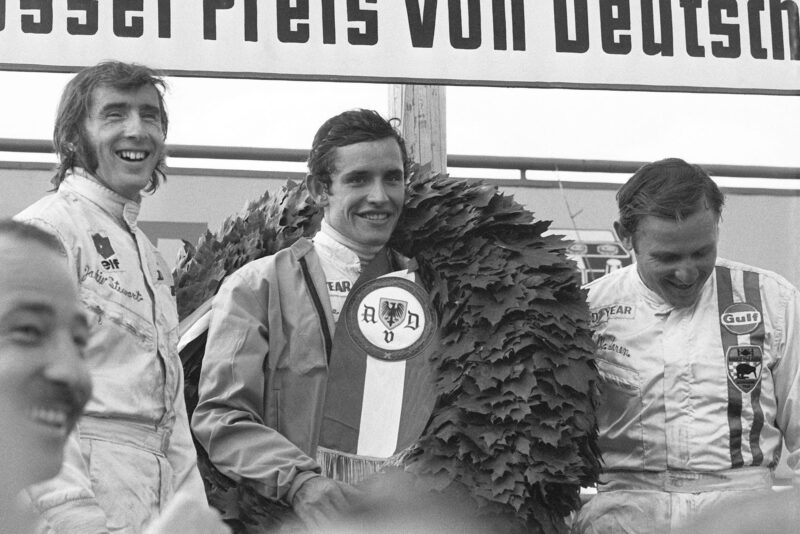
Ickx receives the podium plaudits after winning
Motorsport Images
As Ickx completed his fourteenth and last lap he just failed to lap the Formula Two leader so Pescarolo had to complete another full lap. Ickx received a terrific ovation for a masterly drive at a record-breaking pace and was followed home by Stewart, McLaren and Hill, there being no other Formula One cars left running.
“Ickx received a terrific ovation for a masterly drive at a record-breaking pace”
While Pescarolo continued his lonely final lap to be fifth overall and win the Formula Two race, Stommelen, Attwood and Ahrens were racing for the chicane and second place. As they headed for the finishing line flames came out from under the Winkelmann Lotus and Stommelen had to case off. A fuel tank leak had been dripping into the undertray and contact with something hot had ignited it.
With great presence of mind Stommelen drove towards the finish line where he knew there was a fire-marshal and the flames were quickly put out, but this incident had lost him second place though he was lucky not to receive any burns. Had he stopped suddenly the whole lot might have gone tip in flames, instead of just an odd pipe and wire catching alight.
Like the British Grand Prix at Silverstone this had been Grand Prix racing at its best. This time Stewart’s erstwhile rival was not in the picture and it was the combined skill and superior circuit knowledge of Ickx that provided the opposition and came out on top. The young Belgian boy was justifiably proud of his victory, for to win a race on the Nürburgring is to win a real motor race.
Nurburg Rings
- Andretti cost Lotus a small fortune, for apart from the cost of bringing him from America there were two wrecked engines and a badly bent racing car.
- What a splendid morale booster the victory was for the Brabham team, especially for Jack Brabham who was watching the race balanced on crutches.
- It was a smiling day for Goodyear; they haven’t won a Grand Prix for so long that they were beginning to forget how to smile. And Gulf Petrol have known all along that Ickx was their “Golden Boy”.
- To give a sense of proportion to aspiring Nurburgring “aces” the Austrian Dr Marko lapped in 9min 51.7sec while winning the supporting Formula V race driving a Volkswagen-powered McNamara-Sebring single-seater car. An average of 138.9kph.
- Rumour says that General Motors are sick of Ford domination in European racing and intend to use Opel to do something about it. As all ten finishers in the Formula One and Formula Two categories were Cosworth-powered and designed, and built with Ford money, it would seem that General Motors might well have something to be sick about.
